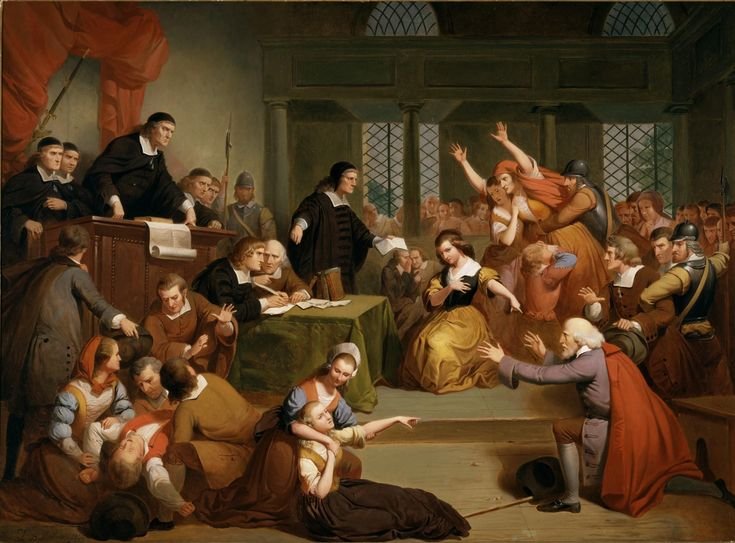The Salem Witch Trials (1692): Fear, Religion, and Power in Early America
- American history Medieval history
 Tanishka Sarang
Tanishka Sarang- February 24, 2025
- 0
- 11

The Salem Witch Trials of 1692 remain one of the most infamous episodes of mass hysteria in American history. Taking place in Salem, Massachusetts, these trials led to the execution of twenty people and the imprisonment of many others, under the accusation of practicing witchcraft. The events reflected deep anxieties about religion, social order, and power in Puritan New England. However, beyond the supernatural claims, the trials were also shaped by political instability, economic rivalries, and social tensions within the community. The Salem Witch Trials serve as a dark reminder of how fear, when combined with a rigid religious and legal system, can lead to devastating consequences.
Women as Primary Targets
The vast majority of those accused and executed during the trials were women. Of the twenty people who were executed, fourteen were women, and many others were imprisoned. This pattern is not coincidental; rather, it reflects a long history of associating women with witchcraft and moral corruption. In Puritan society, women were expected to be submissive, and devoted to their families. Any deviation from this ideal whether through outspoken behavior, economic independence, or nonconformity could put a woman in vulnerable positions and be accused of witchcraft.
Several of the accused women fit this pattern. Sarah Good, for example, was a poor, homeless woman who did not adhere to Puritan standards of femininity. Rebecca Nurse, on the other hand, was a well-respected elderly woman, yet her status did not protect her when accusations arose. Even those from powerful families, like Bridget Bishop, were not immune if they exhibited traits that challenged traditional gender roles.
The Criminalisation of Female Power
Many of the women accused of witchcraft were those who held some form of autonomy—whether financial, social, or intellectual. Widows, for instance, were particularly vulnerable to accusations because they existed outside the traditional family structure and often controlled property, something that threatened the male-dominated order. Women who acted as healers or midwives were also at risk because their knowledge of medicine and childbirth positioned them as figures of authority, independent from male oversight.
The accusations against these women served as a way to reinforce gender hierarchies. By labelling independent or assertive women as witches, Puritan society effectively punished those who stepped outside of their expected roles. This reflects a broader historical pattern in which women who exercised power through speech, knowledge, or economic success were demonised and silenced.
Religious Fear and Puritan Society
The Puritan society of seventeenth-century Massachusetts was built on strict religious beliefs, with an emphasis on morality, discipline, and an unwavering devotion to God. Puritans believed that they were creating a pure, godly society in the New World, one that would serve as a model for the rest of the world. This belief, however, also made them highly intolerant of dissent or perceived threats to their religious and social order.
A fundamental part of Puritan theology was the belief in the Devil’s active presence in the world. Ministers frequently preached that Satan was constantly trying to corrupt the faithful, and anyone who strayed from the accepted norms of Puritan behavior could be accused of working for him. Witchcraft was considered a real and dangerous threat, and those accused of it were believed to have entered into a pact with the Devil in exchange for supernatural powers. The Puritans also believed that witches could harm others by using their magical abilities, making them a danger to the entire community.
In this deeply religious society, church and state were intertwined, and religious leaders had significant influence over legal matters. The legal system itself was based on biblical law, and those accused of crimes—especially moral crimes—often faced severe punishments. This environment created fertile ground for paranoia and suspicion, allowing accusations of witchcraft to escalate into full-scale trials and executions.
The Start of the Witch Hunt
The crisis in Salem began in January 1692, when nine-year-old Betty Parris and her eleven-year-old cousin, Abigail Williams, began experiencing mysterious and disturbing fits. The girls screamed, convulsed, spoke in strange voices, and claimed to be tormented by invisible spirits. Their behaviour alarmed the community, and when a local doctor was unable to find a medical explanation, he declared that the girls had been bewitched.
Under pressure to name those responsible for their afflictions, Betty and Abigail accused three women of practicing witchcraft: Tituba, an enslaved woman from the household of Reverend Samuel Parris; Sarah Good, a homeless beggar; and Sarah Osborne, a widow who had been involved in land disputes. These three women were immediately arrested and interrogated. While Good and Osborne denied the charges, Tituba, possibly under coercion, confessed. She claimed that she, along with other witches in the village, had made a pact with the Devil. Tituba’s confession set off a wave of hysteria, and more people were soon accused of being witches.
The Trials and Executions
As fear spread throughout Salem, the number of accusations increased rapidly. Within a few months, dozens of people were arrested, and the colonial government established a special court, the Court of Oyer and Terminer, to handle the trials. The court relied heavily on spectral evidence—testimonies in which accusers claimed they saw the spirits of the accused harming them. This type of evidence was impossible to disprove, making it nearly impossible for the accused to defend themselves.
The first person to be executed was Bridget Bishop, who was hanged on June 10, 1692. Over the next few months, nineteen more people—fourteen women and five men—were also executed by hanging. One man, Giles Corey, refused to enter a plea and was subjected to a brutal form of torture known as pressing, in which heavy stones were placed on his chest until he was crushed to death. Several others died in jail while awaiting trial.
The victims of the trials came from all walks of life. Some, like Sarah Good, were social outcasts, while others, like Rebecca Nurse and John Proctor, were respected members of the community. The fact that even well-regarded individuals could be accused demonstrated how deeply the hysteria had taken hold of Salem. No one was truly safe, and neighbours began turning against one another in an effort to protect themselves.
Causes of the Hysteria
Historians have long debated the causes of the Salem Witch Trials, and while no single explanation fully accounts for the events of 1692, several factors contributed to the widespread panic.
One of the primary causes was the religious and social structure of Puritan society. The Puritans lived under strict moral codes, and any deviation from the norm was seen as a threat. The fear of witches was not just about supernatural forces—it was also about maintaining control over the community and ensuring that everyone conformed to Puritan values. The trials provided an opportunity to enforce religious discipline and eliminate individuals who were perceived as disruptive or nonconforming.
Political instability also played a significant role. Massachusetts had recently lost its royal charter, creating uncertainty about the colony’s legal authority. Additionally, the region was embroiled in conflicts such as King William’s War, which left the colony vulnerable to attacks from Native Americans and the French. These external threats heightened the sense of fear and anxiety, making people more susceptible to believing that their problems were caused by witches working with the Devil.
Some historians have also explored medical and psychological explanations for the events. One theory suggests that the afflicted girls may have suffered from mass hysteria, a psychological phenomenon in which groups of people experience shared delusions or panic. Another theory proposes that ergot poisoning, caused by a hallucinogenic fungus found in rye, may have led to symptoms such as convulsions and hallucinations, which were misinterpreted as evidence of witchcraft.
The End of the Trials
By October 1692, public opinion had begun to turn against the trials. Prominent ministers, including Increase Mather, argued that spectral evidence was unreliable and should not be used in court. Governor William Phips responded by dissolving the Court of Oyer and Terminer and ordering a halt to the executions. The following year, those who remained in prison were released, and the trials officially came to an end.
In the years that followed, many of those involved in the trials expressed regret for their actions. In 1711, the Massachusetts government formally apologised and offered financial compensation to the families of those who had been executed. However, the damage had already been done, and the events of 1692 left a lasting mark on American history.
Legacy of the Salem Witch Trials
The Salem Witch Trials remain a powerful symbol of mass hysteria, religious extremism, and injustice. The trials demonstrated how fear and suspicion, when left unchecked, can lead to devastating consequences. They also exposed the dangers of relying on unreliable evidence in legal proceedings and helped shape the development of fairer judicial practices in the American legal system.
The cultural impact of the trials has been significant, inspiring numerous books, plays, and films. Arthur Miller’s play The Crucible, written in 1953, used the events of 1692 as an allegory for McCarthyism, when the U.S. government targeted suspected communists in a similar wave of fear-driven accusations. Today, Salem has embraced its history, with museums, historical sites, and annual events that educate visitors about the lessons of the trials.
Conclusion
The Salem Witch Trials serve as a chilling reminder of what can happen when fear and superstition override reason and justice. The events of 1692 were not just about witchcraft—they were about power, control, and the consequences of mass paranoia. As history continues to unfold, the lessons of Salem remain relevant, reminding us of the importance of critical thinking, due process, and the dangers of scapegoating those who are different.


